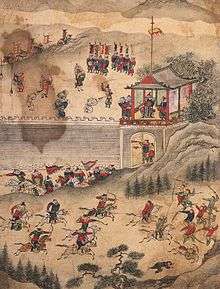Battle of Bukgwan
The Battle of Bukgwan was a confrontation between Joseon and Japanese forces in Hamgyong province, Joseon from 20 September 1592 to 28 February 1593. During the battle, the "Righteous army" (a civilian militia) led by Jeong Mun-bu executed rebels and repelled the Japanese army.[1]
| Battle of Bukgwan | |||||||
|---|---|---|---|---|---|---|---|
| Part of the Imjin War | |||||||
 Changuitowaedo describing Battle of Bukgwan | |||||||
| |||||||
| Belligerents | |||||||
|
|
Rebel forces of Hamgyong | ||||||
| Commanders and leaders | |||||||
|
Jeong Mun-bu Jeong Hyeon-ryong |
Katō Kiyomasa Nabeshima Naoshige Guk Gyeong-in † Guk Se-pil † | ||||||
| Strength | |||||||
| 5,000 | 22,000 | ||||||
| Casualties and losses | |||||||
| Unknown | 8,864 | ||||||
| Korean name | |
| Hangul | |
|---|---|
| Hanja | |
| Revised Romanization | Bukgwan Daecheop |
| McCune–Reischauer | Pukkwan Taech'ŏp |
Background
The Japanese 2nd Army, led by Katō Kiyomasa, captured Hanyang in May 1592. Then, they headed toward Hamgyong province. At the time, residents of Hamgyong were hostile to the government because of discrimination against them. Moreover, their hostility was escalated by Prince Imhae and Sunhwa who plundered them of clothes, foods, and other necessities. Guk Gyeong-in and his uncle Guk Se-pil handed the two princes over to the Japanese.[2] There was public unrest regarding Japanese force because they started exploitation them. Ji Dal-won sensed the change of popular opinion and asked Jeong Mun-bu, who had been hiding, to be a leader of a righteous army. Jeong Mun-bu accepted the proposal and raised an army including Kang Mun-woo. With his army, he held Kyongsong where Guk Se-pil was stationed. Then, he issued a declaration and Jeong Hyeon-ryong, Oh Eung-tae, and other soldiers joined with their army.[3]
Battle
Execution of Rebels
Japanese armies noticed that the righteous army led by Jeong Mun-bu had occupied Kyongsong. They detached 100 scout forces to survey the situation. Thereupon, Kang Mun-woo and his cavalry repelled them.[3] Jeong Mun-bu executed Guk Se-pil before they planned to retake Kilju. And he posted a notice saying they raised a righteous army and asked to execute rebels left including Guk Gyeong-in and Jeong Mal-su. Shin Se-jun, a student of Confucianism living in Hoeryong, set fire to the house of Guk Gyeong-in and killed him.[4][5] Jeong Mun-bu ordered Gu Hwang and Kang Mun-woo to recapture Myongchon. They killed Jeong Mal-su with a peasant revolt and recaptured Myongchon.[6]
Battle of Kilju
Jeong Mun-bu besieged Kilju splitting his troops into groups of three. In late October 1592, Jeong Mun-bu made a surprise attack on the Japanese army returning after they looted the nearby town and killed hundreds of army. Japanese in Kilju closed the fortress and focused on defense. Jeong Mun-bu surrounded them and hindered them from getting firewoods. Around December, Jeong Mun-bu defeated reinforcements in Ssangpo.[5] On 19 January 1593, the isolated Japanese force tried to escape but their attempt failed when they were ambushed. On 22 January, Jeong Mun-bu and his 200 cavalry troops the exterminated Japanese army in Tanchon, south of Kilju. Kato Kiyomasa received a report that Kilju was in peril and marched north, leading over 20,000 soldiers. Jeong Mun-bu withdrew his forces from Tanchon after Kato crossed Macheollyeong.[7] Jeong Mun-bu ambushed Kato and his troops in Immyong but failed and withdrew. Kato met the isolated army and retreated to Anbyon that night.[8]
Aftermath
Kato rescued isolated units and assembled his troops in Hamhung on 20 February and retreated to Anbyon.[8][9] On 29 February, Kato arrived at Hanyang and noticed they lost 8,864 of 22,000 soldiers. After the retreat of the Japanese, the righteous army disbanded and Yoon Tak-yeon took command. Jeong Mun-bu had friction with Yoon Tak-yeon, who took undue credit for the victory. Jeong Mun-bu was credited only for executing rebels.[10]
See also
References
- (in Korean) Battle of Bukgwan at Doosan Encyclopedia
- (in Korean) Guk Gyeong-in at Encyclopedia of Korean Culture
- (in Korean and Chinese) Veritable Records of Seonjo (revision) 25th September
- (in Korean) Shin Se-jun at Doosan Encyclopedia
- (in Korean and Chinese) Veritable Records of Seonjo (revision) 25th October
- (in Korean) Jeong Mun-bu at Doosan Encyclopedia
- (in Korean and Chinese)Veritable Records of Seonjo (revision) 26th January - 5
- (in Korean) Battle of Bukgwan at Encyclopedia of Korean Culture
- Hawley 2005, p. 311.
- (in Korean and Chinese)Veritable Records of Seonjo (revision) 26th January - 6
Bibliography
- Hawley, Samuel (2005), The Imjin War, The Royal Asiatic Society, Korea Branch/UC Berkeley Press, ISBN 89-954424-2-5